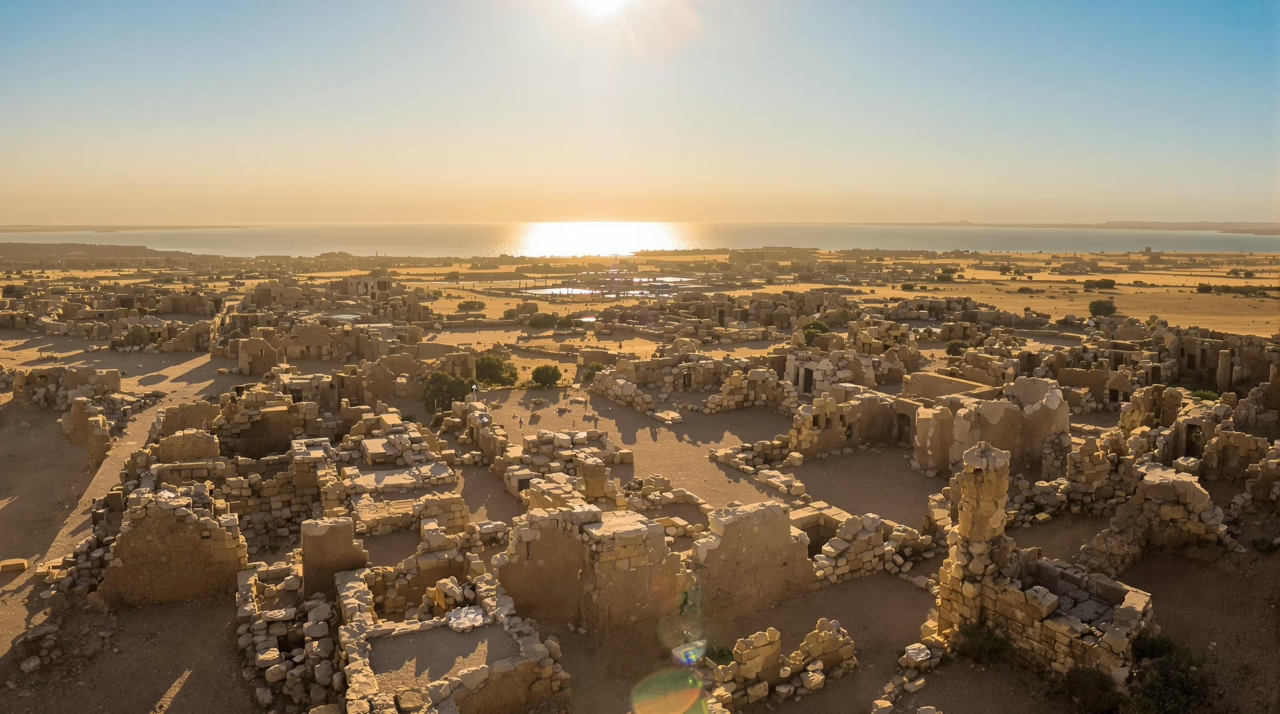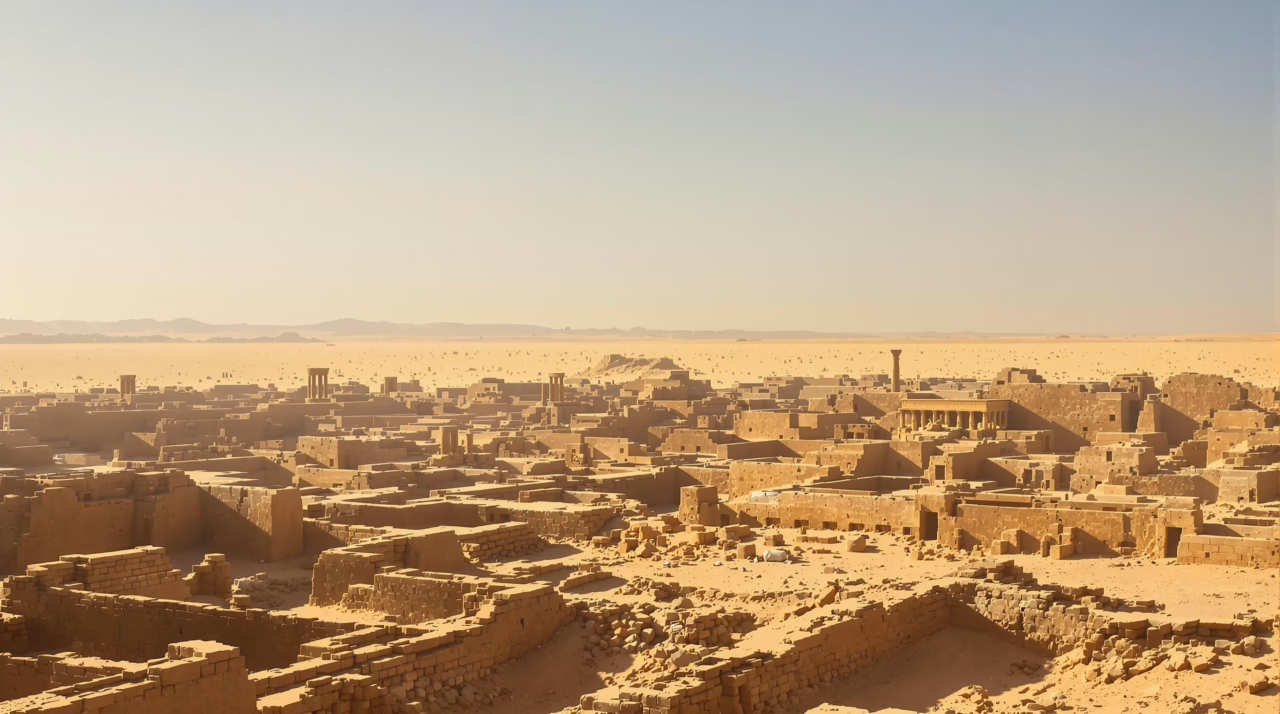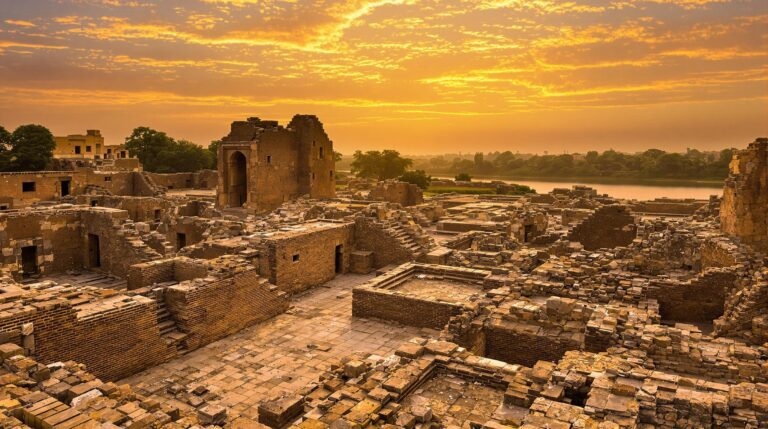Thinis: Egypt’s Forgotten First Capital

Thinis remains a largely overlooked chapter in Egypt’s ancient history. Its significance in the early dynastic period cannot be understated.
As a center of trade, culture, and governance, Thinis shaped the foundations of a unified Egypt. Yet, its narrative has faded, overshadowed by more prominent cities.
What factors contributed to its obscurity, and how does its legacy continue to influence modern understandings of ancient Egyptian civilization?
The answers may reshape perceptions of this forgotten capital.
Principal Conclusions
Hide- Thinis was Egypt's first capital, pivotal in shifting from fragmented communities to centralized authority during the Early Dynastic period.
- The city played a crucial role in the unification of Upper and Lower Egypt, fostering political alliances and military innovations.
- Advanced irrigation systems and agricultural practices in Thinis supported local sustenance, trade, and economic prosperity.
- Thinis served as a key trade hub, facilitating cultural exchanges and establishing social ties that influenced regional dynamics.
- Modern archaeological efforts are uncovering Thinis's significance, reshaping our understanding of early Egyptian civilization and urban governance.
The Rise of Thinis in Early Dynastic Egypt

The rise of Thinis during Early Dynastic Egypt marks a pivotal shift from fragmented communities to centralized authority.
As a significant power in the Predynastic landscape, Thinis played an essential role in shaping the emerging structures of governance and social organization.
This evolution not only laid the groundwork for dynastic rule but also influenced the cultural and political dynamics that defined ancient Egypt.
Setting the Stage for a Predynastic Power
The political landscape of early Dynastic Egypt was characterized by a patchwork of tribal affiliations and local kings, each vying for control and influence.
In this setting, Thinis emerged as a significant power center, strategically positioned to consolidate authority amidst competing factions.
Understanding the dynamics of these tribal leaders and their regional dominance is essential to comprehending Thinis’s ascent and its role in shaping Egypt’s unified state.
Political Landscape Before Unified Rule
While many ancient civilizations have left indelible marks on history, the political landscape of early Dynastic Egypt, particularly in the region surrounding Thinis, reveals a complex tapestry of power dynamics and cultural evolution that laid the groundwork for future unification.
Local interactions, shifting allegiances, and emerging hierarchies created a fertile environment for Thinis, setting the stage for a cohesive Egyptian identity.
Influence of Tribal Leaders and Local Kings
Emerging from the complex political landscape of early Dynastic Egypt, Thinis became a focal point for tribal leaders and local kings whose influence shaped the region’s development.
These leaders fostered alliances and engaged in strategic power plays, facilitating trade and cultural exchange.
Their authority laid the groundwork for societal organization, ultimately paving the way for Thinis’s prominence as a significant cultural and political center.
The Emergence of Dynastic Authority
The rise of Thinis as Egypt’s first capital marked a transformative period characterized by the strategic interplay of warfare, alliances, and land consolidation.
These elements not only forged a unified identity for the nascent kingdom but also established a framework for dynastic authority that would influence future Egyptian governance.
Warfare, Alliances, and Consolidation of Land
Warfare and strategic alliances played pivotal roles in the rise of Thinis, shaping the landscape of early Dynastic Egypt.
Key factors included:
- The unification of Upper and Lower Egypt
- Formation of coalitions with neighboring tribes
- Tactical military innovations that secured territorial gains
- Diplomatic marriages strengthening political ties
These elements forged a nascent authority, enabling Thinis to emerge as a formidable center of power.
Shaping the Identity of an Early Kingdom
As Thinis solidified its power through military conquests and alliances, the cultural and political landscape of early Dynastic Egypt began to take shape, reflecting a complex identity that would influence future generations.
This emergence of dynastic authority fostered a sense of unity, intertwining local traditions with centralized governance, ultimately laying the groundwork for a civilization that celebrated both individuality and collective identity.
Urban Life and Cultural Milestones
In examining the urban life of Thinis, one encounters a complex interplay of architecture and city layout that reveals the societal values and priorities of its inhabitants.
The prominence of religious practices and the worship of deities within the city not only shaped its physical space but also fostered a rich cultural identity that has largely been overlooked.
Understanding these elements offers insight into the foundational role Thinis played in the evolution of Egyptian civilization.
Architecture and City Layout
The architecture of Thinis reveals a sophisticated urban plan characterized by formidable fortifications, grand temples, and distinguished noble residences, reflecting the city’s political and religious significance.
The strategic placement of these structures was intricately linked to the Nile, which not only served as an essential resource but also influenced trade routes and agricultural practices.
This interplay between natural geography and human ingenuity underscores the cultural milestones that defined life in Egypt’s first capital.
Fortifications, Temples, and Noble Residences
Fortifications, temples, and noble residences stand as monuments to Thinis’ architectural ingenuity and societal structure, reflecting the city’s significance as Egypt’s first capital.
These structures reveal much about urban life and culture:
- Defensive walls showcasing military prowess
- Temples indicating religious devotion and community focus
- Residences of nobility illustrating social hierarchy
- Public spaces fostering civic engagement and interaction
Each aspect contributes to Thinis’ rich historical narrative.
Role of the Nile in Urban Planning
Flowing alongside Thinis, the Nile was not merely a geographical feature but an essential force shaping the city’s urban landscape and cultural milestones.
Its banks provided fertile soil, influencing agricultural practices and settlement patterns. The river’s predictable floods enabled strategic planning, fostering trade routes and communal gatherings, while inspiring architectural endeavors that reflected the civilization’s values, aspirations, and interconnectedness with the natural world.
Religious Practices and Deities
The religious landscape of Thinis reveals a complex interplay between local deities and the emerging state religion, reflecting the city’s pivotal role in early Egyptian spirituality.
Archaeological evidence from tomb complexes provides insight into how these local gods were venerated and integrated into broader religious practices.
Also read:
- Harappan Civilization: Inside the Planned Cities of the Indus Valley
- Babylon: Ancient City of Power and Mystery
This synthesis of beliefs not only shaped urban life in Thinis but also laid the groundwork for the religious frameworks that would dominate later periods in Egyptian history.
Local Gods and Their Integration into State Religion
While the grandeur of state-sponsored deities often overshadowed local beliefs, the integration of local gods into Egypt’s state religion reveals a complex tapestry of cultural exchange and adaptation.
This syncretism fostered:
- Enhanced communal identity
- Diverse religious practices
- Localized rituals
- A richer pantheon
Such elements underscored the fluidity of faith, allowing for a dynamic interplay between the divine and the everyday lives of the people.
Archaeological Clues from Tomb Complexes
Tomb complexes in Thinis serve as invaluable archaeological windows into the intricacies of urban life and religious practices in ancient Egypt.
The artifacts unearthed reveal a diverse array of beliefs, rituals, and social structures. Hieroglyphs and burial offerings indicate the reverence for deities, showcasing how spirituality intertwined with daily existence.
These findings illuminate the cultural milestones that shaped Thinis’s historical significance in the ancient world.
Trade, Economy, and Regional Connections
Thinis, as Egypt’s first capital, thrived on its agricultural wealth, which laid the foundation for its economic strength.
The effective management of resources not only sustained its population but also fostered trade networks with neighboring settlements, enhancing regional connections.
This interplay of agriculture and commerce positioned Thinis as a pivotal player in early Egyptian civilization, influencing its socio-economic landscape.
Agricultural Wealth and Resource Management
Thinis’ agricultural wealth was intricately linked to its advanced irrigation systems, which enabled the efficient distribution of crops across the region.
This infrastructure not only supported local sustenance but also facilitated trade, allowing Thinis to emerge as a pivotal economic hub in ancient Egypt.
Additionally, the early record-keeping practices employed to track surplus production underscore the sophisticated resource management that characterized this forgotten capital.
Irrigation Systems and Crop Distribution
While the Nile River’s annual flooding provided the lifeblood for agriculture in ancient Egypt, it was the sophisticated irrigation systems developed by the inhabitants of Thinis that transformed this natural bounty into a thriving economy.
Key elements of these systems included:
- Canals for water distribution
- Wells to access underground aquifers
- Dikes to manage flooding
- Crop rotation practices for sustainability
These innovations fostered regional trade and agricultural prosperity.
Early Record-Keeping to Track Surplus
As agricultural productivity surged in ancient Thinis, the necessity for effective record-keeping emerged as a critical component of economic management.
This early system of documentation allowed for the monitoring of surplus resources, facilitating trade and fostering regional connections.
Networking with Neighboring Settlements
Thinis, as a pivotal trade hub along the Nile, facilitated the movement of goods that not only enriched its economy but also established essential connections with neighboring settlements.
This network of trade profoundly influenced political dynamics, allowing Thinis to expand its influence and assert control over surrounding regions.
The interplay between commerce and governance in Thinis exemplifies how economic activities can shape the trajectory of early civilizations.
Movement of Goods Along the Nile
The movement of goods along the Nile was an essential artery for trade and economic prosperity in ancient Egypt, facilitating the exchange of resources and ideas between Thinis and neighboring settlements.
Key elements included:
- Agricultural produce, such as grain and flax
- Artisan crafts, including pottery and textiles
- Raw materials like gold and copper
- Cultural exchanges that enriched social ties
This lively network fostered regional connections and economic growth.
Influence of Trade on Political Expansion
While the Nile served as an essential conduit for the exchange of goods, it also played a pivotal role in shaping the political landscape of ancient Egypt.
Trade fostered relationships with neighboring settlements, enabling Thinis to assert influence and expand its territory. As economic ties strengthened, political alliances formed, creating a network that allowed Thinis to thrive and solidify its status as a burgeoning power.
Reasons Behind Thinis’ Obscurity
Thinis’ obscurity can be attributed to the shifting centers of power in ancient Egypt, which often overshadowed its significance.
Additionally, the scarcity of physical evidence from Thinis has hindered archaeological and historical recognition, making it more challenging to appreciate its role in early Egyptian civilization.
As a result, this once-prominent capital has faded into the background, raising questions about the factors that contribute to the historical memory of such pivotal locations.
Shifting Centers of Power
The ascendancy of Memphis and Thebes in later periods marked a significant change in Egypt’s political landscape, overshadowing the once-prominent Thinis.
This alteration reveals not only the dynamic nature of power but also the strategic motivations behind the relocation of capitals, often driven by the need for centralized control and military advantage.
As the narrative of Egyptian civilization evolved, Thinis gradually receded into obscurity, prompting questions about the criteria that define historical significance.
Rise of Memphis and Thebes in Later Eras
Amid the sweeping tides of ancient Egyptian history, the emergence of Memphis and Thebes as dominant centers of power marked a significant change that overshadowed Thinis.
Several factors contributed to this alteration:
- Strategic geographic locations
- Economic prosperity through trade
- Stronger military capabilities
- Cultural developments fostering identity
These elements collectively fostered an environment where Thinis fell into obscurity, eclipsed by the rising influence of its successors.
Politically Motivated Moves to New Capitals
While the allure of power often prompts leaders to seek new foundations, the political motivations behind the relocation of Egypt’s capitals reveal a deliberate strategy to enhance control and influence.
As dynasties emerged and rivalries intensified, shifting the capital became a tool for consolidating authority, fostering loyalty, and asserting dominance, ultimately contributing to Thinis’ obscurity in the annals of Egyptian history.
The Rarity of Physical Evidence
The scarcity of physical evidence at Thinis can be attributed to multiple compounding factors, including erosion, looting, and a long history of historical neglect.
These elements not only obscure the remnants of this once-thriving capital but also hinder thorough excavation efforts and documentation of its archaeological significance.
Consequently, the challenge of piecing together Thinis’ past becomes increasingly formidable, leaving its legacy shrouded in uncertainty.
Erosion, Looting, and Historical Neglect
Erosion, looting, and historical neglect have conspired to shroud Thinis in obscurity, rendering it one of Egypt’s most elusive ancient capitals.
The reasons for this neglect include:
- Natural weathering of archaeological sites
- Illicit excavation by treasure hunters
- Insufficient funding for preservation efforts
- Lack of scholarly attention due to competing historical narratives
These factors collectively undermine the opportunity to uncover Thinis’ rich cultural legacy.
Limitations in Excavations and Documenting Remains
Although archaeological endeavors have the potential to illuminate Thinis’ past, significant limitations in excavations and the documentation of remains have hindered a thorough understanding of this ancient capital.
Scarcity of funding, the site’s challenging geography, and insufficient historical records restrict scholarly efforts. Consequently, the absence of robust physical evidence perpetuates Thinis’ obscurity, leaving scholars grappling with a fragmented narrative of its once-vibrant civilization.
Modern Searches and Historical Significance
Recent archaeological efforts have reignited interest in Thinis, shedding light on its pivotal role in early Egyptian civilization.
These modern searches not only aim to uncover artifacts but also challenge existing narratives within Egyptology, highlighting Thinis’ profound legacy and influence.
As scholars reassess its historical significance, the potential for new insights into the origins of statehood and culture in ancient Egypt becomes increasingly apparent.
Renewed Archaeological Efforts
Recent technological advancements in site detection have revolutionized the search for Thinis, Egypt’s elusive first capital.
Collaborative projects among archaeologists and historians are now focusing on pinpointing its exact location, revealing the potential for significant discoveries that could reshape our understanding of ancient Egyptian civilization.
As these modern efforts unfold, they underscore the historical importance of Thinis and its role in the broader narrative of Egypt’s early political landscape.
Technological Advances in Site Detection
Advancements in technology have revolutionized the methods used to detect and explore archaeological sites, particularly in the search for Thinis, Egypt’s forgotten first capital.
These innovations have enabled researchers to employ:
- Remote sensing techniques
- Ground-penetrating radar
- Geographic Information Systems (GIS)
- Drones for aerial surveys
This technological shift not only enhances efficiency but also reveals the historical significance of lost civilizations, fostering a deeper understanding of Egypt’s rich heritage.
Collaborative Projects Aiming to Pinpoint Thinis
As researchers explore deeper into the enigma of Thinis, collaborative projects are emerging that combine the expertise of archaeologists, historians, and technologists to pinpoint this ancient capital.
These interdisciplinary efforts leverage advanced imaging techniques and historical texts, revealing connections between artifacts and geography.
Such initiatives not only aim to locate Thinis but also seek to reclaim a crucial piece of Egypt’s historical narrative.
Legacy and Impact on Egyptology
The significance of Thinis extends beyond its historical footprint, offering scholars critical insights into the complexities of state formation in ancient Egypt.
As researchers examine this forgotten capital, they uncover essential lessons relevant to early urban models, highlighting the interplay between geography, governance, and social organization.
Consequently, the legacy of Thinis serves not only as a focal point for Egyptology but also as a catalyst for broader discussions on the evolution of civilizations.
Inspiration for Scholars Studying State Formation
Although often overshadowed by later capitals like Memphis and Thebes, Thinis serves as a compelling focal point for scholars exploring the complexities of early Egyptian state formation.
Its significance is highlighted by:
- Insights into political organization
- Foundations of social hierarchies
- Cultural development in pre-dynastic times
- The evolution of administrative practices
Thinis offers a unique lens for understanding Egypt’s formative years, enriching Egyptology’s narrative.
Lessons for Understanding Early Urban Models
While exploring the urban models of ancient civilizations, Thinis emerges as a pivotal case study that enriches contemporary understanding of early urbanization.
Its unique socio-political structure and resource management strategies offer insights into how urban centers facilitated governance and economic exchange.
Wrapping Up
In the shadows of Egypt’s illustrious history, Thinis stands as a silent sentinel, its echoes whispering tales of unity and innovation.
Once a lively tapestry of culture and commerce, it now lies cloaked in the mists of time, urging modern scholars to unravel its mysteries.
As the Nile flows steadily onward, so too does the quest to reclaim Thinis from obscurity, reminding us that even the most forgotten capitals can illuminate the path of civilization’s evolution.





